 Silkies are among the hardest breed of chickens to sex at a young age. The old adage that you can’t tell them apart until they crow or lay an egg has a lot of truth in it. I have found that certain weeks of age are easier than others for telling which are boys and which are girls.
Silkies are among the hardest breed of chickens to sex at a young age. The old adage that you can’t tell them apart until they crow or lay an egg has a lot of truth in it. I have found that certain weeks of age are easier than others for telling which are boys and which are girls.
Newborns that are hatched together out of the same color pen can be judged on size. Males tend to be larger and more curious than the females. This only works with same color chicks. If you want more information about sexing younger silkies, check out “sexing young silkie chicks.
At around three weeks, males will begin to be more aggressive and will play fight with other males in the same pen. Beware – females can do this also. The silkie comb on males may begin to show some signs of development from three weeks onward. A upside down “U” at the top part of the comb may be the beginning of a wider developing comb and signal a male. Females tend to have a more narrow upside down “V” at the top of their combs.
Males will continue to develop their combs which will become wider and may get bumpy. After twelve weeks the female comb begins to get wider as well and males and females will begin to look similar again.
AT VJP Poultry we have a rooster return policy. I had a customer return a rooster for rehoming last week that was around four months old. I asked him why he thought it was a rooster at that young age and he said that it was because it had a mean disposition. I put my hand down next to it and it immediately pecked it – hard!
After the customer left, I began looking more closely at the bird. It was a pet quality partridge or buff silkie. The color was wrong for the show ring. The more I looked at it, the more I just couldn’t get a handle on whether I thought it was a boy or a girl.
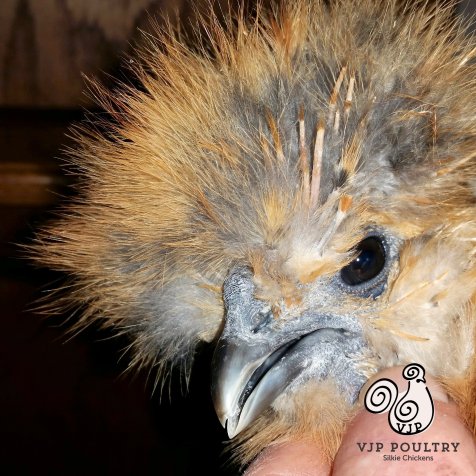
The first thing I did was to trim around the eyes. It was unable to see and this could have been part of the reason that it pecked so hard at my hand. I took a look at the comb and wattles. The comb was wider than younger females but at four months female silkie’s combs begin to grow. I looked for wattles. At four months they should be showing on a male. I begin to see them as young as two months old as small red dots. This bird had just the slightest suggestion of the outline of a wattle. Again, females will develop very small wattles as they grow towards maturity.
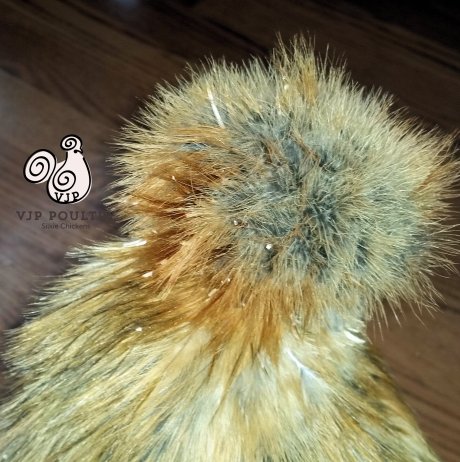
The crest of this bird had a definite pom pom shape. Because I didn’t see this bird when it was younger, I don’t know if it went through any Elvis type crest that some males have beginning at two months. I looked at the back of the head to check for “streamer” development. Nothing so far, but there are new feathers coming in right at the spot that could later develop into streamers.
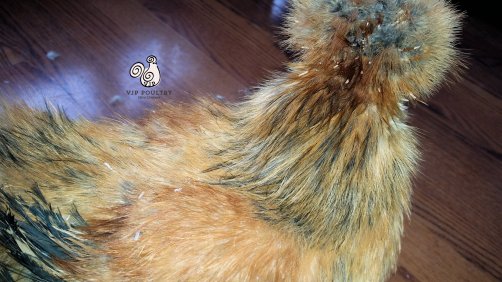
Next I looked at the hackle feathers on the neck. Males should have longer hackle feathers than the females at this point. I did not have another to compare it with but they looked shorter and more female to me.
The wings on the bird looked long, especially the primaries. They also seem to be hard or stiff – not shreddy. Just because they seem large, it makes me think male. Females have shorter primary feathers.
The tail is wide and stands up straight. I also think that this is a male characteristic. Females often have their tail down in a more submissive position.
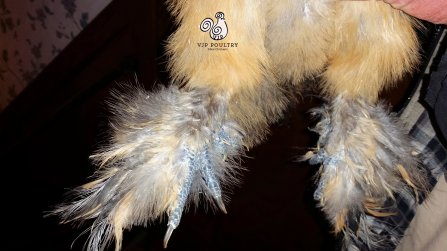
This silkie has large feet and massive foot feathering. This is another sign of a male. Females foot feathering are more in proportion to the rest of its body. Foot feathering depends on breeding but males will have larger feet.
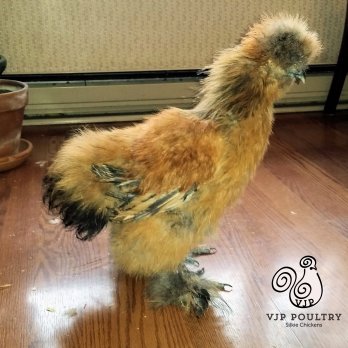
The stance of this bird is very upright. Boys stand up taller than girls as a rule and there is more room between the tail and the bottom of the feet.
Behavior is hard to tell since I didn’t see how it developed. It seems very docile once its eye feathers were trimmed. It is currently alone so I can’t see how it interacts with others. Males would be more assertive. If you placed it with another male, they may begin to fight even at this young age.
Males at four months are often crowing especially first thing in the morning. This bird only made soft clucking sounds like a hen would make. It did not struggle when you picked it up and did not make grunting sounds like a male may make.
So let’s look at the score card:
Comb- Female Wattles- female
crest – female hackle feathers – female
wings – male tail – male
feet – male stance – male
behavior- either noises – female
If I was pressed I would have to go with male, but it certainly could go the other direction.
This article is to show how hard it is to determine the sex of a young silkie. Mistakes can be made. Breeders and judges alike are not always certain when sexing silkies. I do think that it is much easier to sex them if you watch how they grow and develop. Taking a four month old juvenile silkie and trying to sex it in isolation is much more difficult. Hopefully, a crow will come sooner or later – or maybe an egg.
For tips and tricks for raising outstanding silkies check out our Chicken Learning Center at VJPPoultry.com . VJP Poultry is an NPIP and state inspected hatchery located 30 miles north of St. Paul. We hatch out silkies all year long so we always have stock available. Like us on Facebook to get weekly updates on what we currently have for sale.
Victoria J. Peterson
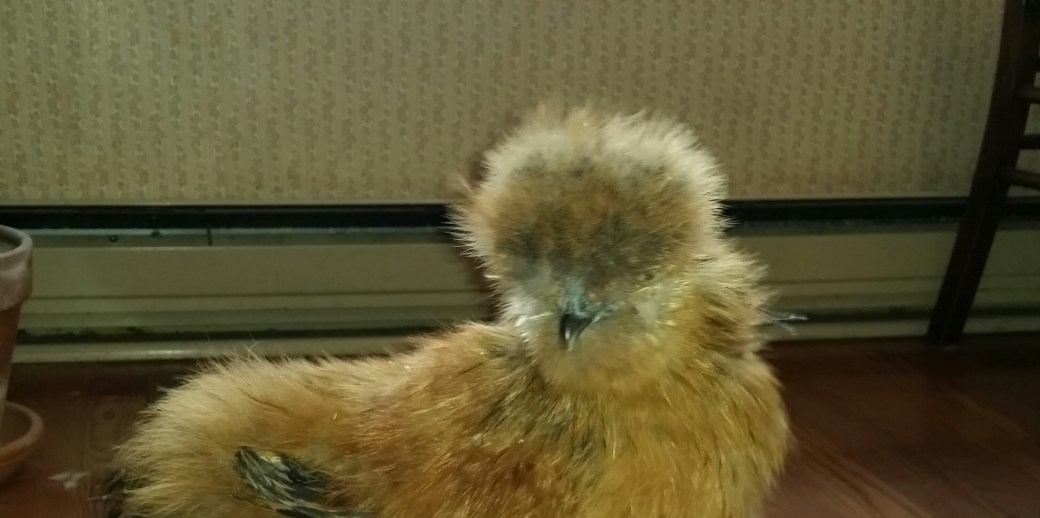
Is it true male Male silkies will develop wattles early on and females will develop closer to laying age? I have 8 chicks. At 7 weeks, 3 had wattles and now at 10 weeks, 6 have wattles. 7 of the 8 are very rambunctious and play fight alot. I fear I may have 6 to 7 roosters. I just recently found your site while researching silkies and heat stress. I have 5 adult hens just over a year old and 2 have been struggling with soft shell eggs . I think mostly because they free range longer and don’t eat the layer feed. They don’t touch the oyster shell but pick at crumbled egg shells. I’ve been giving them a fried egg daily with tums crushed up in it. That has helped but at least once a week one of the 2 is egg bound or just drops a soft egg wherever she is at. I do appreciate this site. Don’t have a clue what I’m going to do with 6 roosters if the wattles are a sure sign.
Wattles are not a sure sign. I have found that in certain colors of my flock , females will have tiny visible wattles at 3 months. This can be confusing, as silkie sexing always is. I have never heard of anyone using tums and I wouldn’t recommend it. We offer oyster shell and sprinkle it on their regular feed.
Thank you. I do offer oyster shell and crushed egg shell. I also ordered some powdered oyster shell. I leave some in a separate bowl and mix some with the food. I read about the tums when researching egg bound hens. It just seems they don’t touch the oyster shell but they will eat the egg shells. I will stop giving them the tums. Do you have any other suggestions? Again, Thank you so much.
Thank you. I do offer oyster shell and crushed egg shell. I also ordered some powdered oyster shell. I leave some in a separate bowl and mix some with the food. I read about the tums when researching egg bound hens. It just seems they don’t touch the oyster shell but they will eat the egg shells. I will stop giving them the tums. Do you have any other suggestions? Again, Thank you so much.
The problem of having an egg bound hen probably has nothing to do with the calcium. Most hens will instinctively eat the calcium they need to produce egg shell. Soft shell do happen but usually go away. If you are concerned I would check with a poultry vet in your state.
Thank you. I did take her to the vet and she said to keep them locked up longer. Put them up earlier. Less free range time and to sprinkle the layer feed on the ground to encourage them to eat it. It only started happening this summer, so we assumed they were free ranging and not eating their layer feed. I was throwing it out daily. Really appreciate your help. Thought it was a lack of calcium!
This post is more than a year old, so now what is the verdict? Is it male or female? Can you add a paragraph to the post? Curiously to know. Looking at the pic the neck hair is like my silkie rooster, its long, my silkie hen neck hair is much shorter.
The chick ended up being a girl!